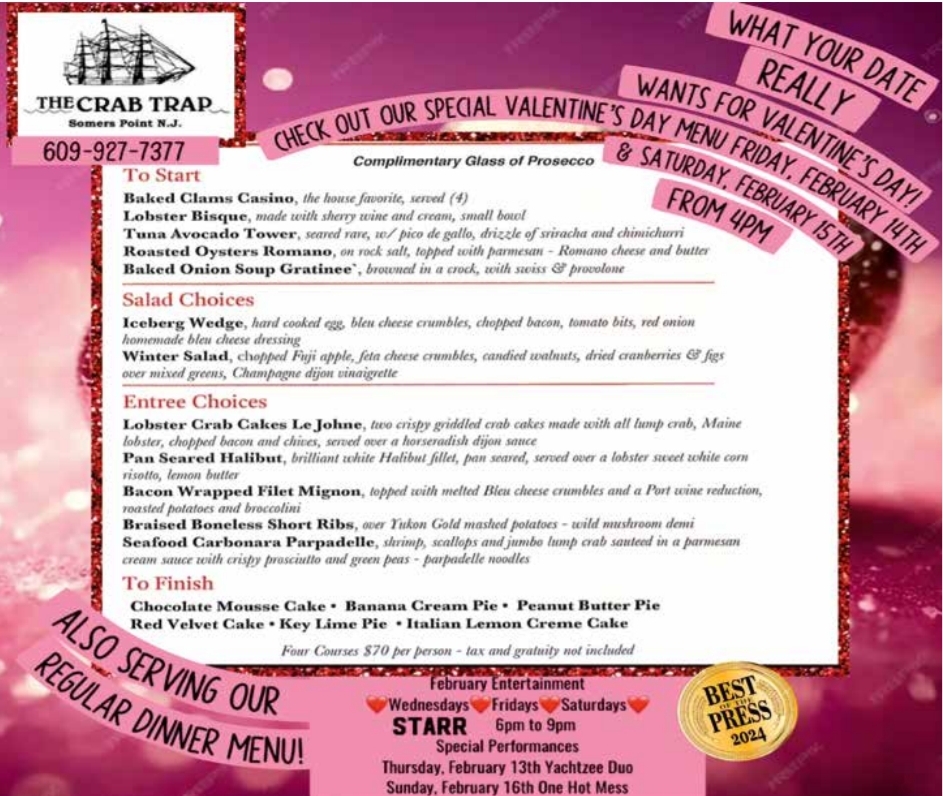Drink Up!
By David Setley
Aah, February. Cupid is on the loose and romance is in the air! Hallmark movie images come to mind of hand-holding, hugging, and forehead kisses. It’s safe to say that skin contact is integral to romance… and it is to winemaking as well. Did you know that almost any wine grape, red or white, can be made into white wine?
Wine can be made from fruit other than grapes – think of the blue wines made from blueberries. However, for this discussion, we’ll stick with wines made from the Vitis Vinifera species of grape, also known as the common European grapevine, that is used to make the overwhelming majority of wine throughout the world. There are two primary colors of grapes used in winemaking: red and white (those that look green). There are four primary colors of wine produced from grapes: red, white, pink (rosé or blush), and orange (amber). There are as many as 36 identified variations of these colors from pale straw to deep purple and all the hues in between. So, is red wine made from red grapes and white wine made from white grapes? Yes…and no! It is not necessarily the color of the grape that determines the color of the wine, although it often does. For example, Pinot Grigio or Pinot Gris grapes are light purple to blueish grey in color, yet the wine made from these grapes is a pale-yellow white wine. However, White Zinfandel, a blush-colored wine, is actually made from a grape that has a nearly black skin.
How does this happen? It all comes down to skin contact! The pulp of nearly all grapes, regardless of skin color, is white. Immediately after grapes are harvested, they are gently crushed in machinery made for this process. Stomping grapes with bare feet is rarely done anymore. Crushing separates the juice, called “must,” from the skins, stems, and seeds of the grapes, called “pomace.” The winemaker then decides whether fermentation will occur with the must and pomace remaining in contact or not. If white wine is the goal, the skins are removed from contact with the juice. If the goal is a pink, orange, or red wine, the skins will remain in contact with the juice for a determined period of time. This is called maceration. During cold-soak maceration, tannins, a compound in pomace, is transferred to the juice, resulting in the wine’s color. Maceration can last as little as 12 hours and as long as five days. Generally, the longer the maceration period, the darker the color of the resulting wine. For some lighter-tannin red wines, such as Pinot Noir, this pre-fermentation cold-soak is sufficient. For richer, more full-bodied reds, such as cabernet sauvignon or merlot, an extended maceration is performed after fermentation for anywhere from three to 100 days. Tannins also add as many as 300 different flavor characteristics, as well as dryness, that adds to the complexity of the wine.
There is an exception. Teinturier grapes have red pulp as well as red skins. These grapes are rare. The three most common examples are Chambourcin, Saperavi, and Alicante Bouschet. When these grapes are crushed, the juice is red, not white, like Pinot Gris. To experience these teinturier grapes, try the 8K Saperavi from Georgia or Cartuxa Evora Alicante Bouschet blend from Portugal.
A rosé has a very short maceration period, but what about orange wines? While rosé wines are made from red-skinned grapes such as Grenache, Pinot Noir, Nebbiolo, Merlot, orange wines are made from white grapes such as Pinot Gris, Verdejo, Chardonnay, Gewürztraminer, and Rkatsiteli. Short maceration of red skins result in a rosé wine. The same process with white-skinned grapes results in an orange wine. Again, it’s all about skin contact.
Experience the importance of skin contact for yourself this February…in wine, of course! I mentioned Pinot Gris is a red-skinned grape used to create a white wine. Try the A to Z Wineworks Pinot Gris or the Montinore Estates Pinot Gris. Both are from Oregon and are dry white wines that are light and refreshing with flavors of pear and white peaches.
Experience the effect of short maceration of red-skinned grapes through a rosé wine. I recommend the Nik Weis Pinot Noir Rosé from Mosel, Germany, or the Kir Yianni Xinomavro Rosé from Greece. Orange wines, while among the most ancient wines still in production, have been gaining attention in recent years. Glekhuri Qvevri Rkatsiteli is an ancient wine from the Middle Eastern country of Georgia. This is a skin-contact wine utilizing a white grape called Rkatsiteli. Or, try Spain’s Gulp Hablo Orange wine made from Verdejo, or Oregon’s Montinore Estates Montinore L’Orange that is made from a blend of white grapes. Notice the difference in flavor, aroma, and dryness between white wines with no tannins, and rosé or orange wines that have just a touch of tannin.
To experience the difference between short and long maceration periods of red grapes, compare the Balletto Vineyards Pinot Noir from the Russian River Valley of California and the Chateau Carbonneau from Bordeaux, France, made of Merlot, Cabernet Franc, and Malbec. The Balletto Pinot Noir is lighter in color and body. The Bordeaux blend is darker and fuller-bodied. The longer skin contact adds color, flavor and texture!
Winemaking is an art form. How skin contact is or is not utilized by the winemaker makes a significant difference in the wine. I hope this article has added to your understanding of skin contact in the art of winemaking and encourages you to experience some “skin contact” this Valentine’s weekend. As always, contact me with any questions or comments at dsetley@passionvines.com, or stop into the Somers Point store. Until next time, Happy Valentine’s Day and Happy Wining!















